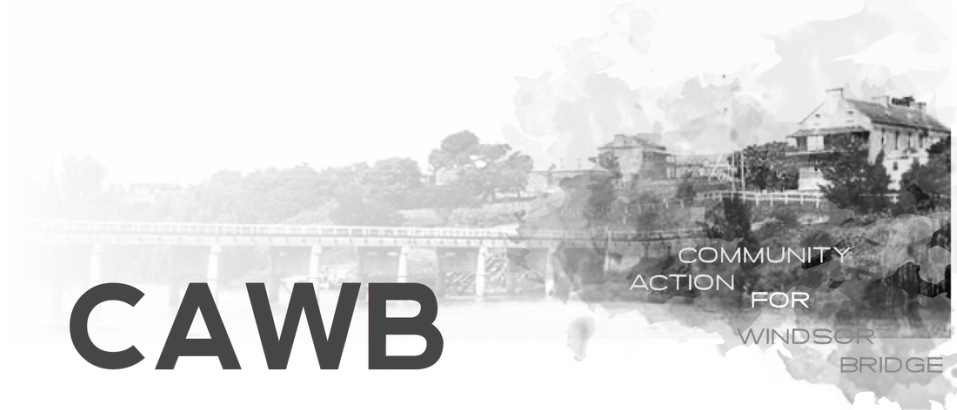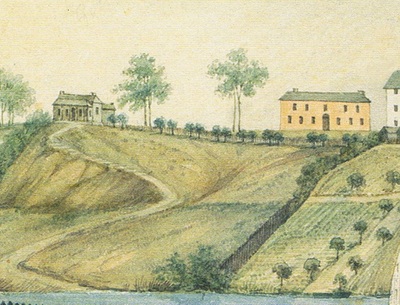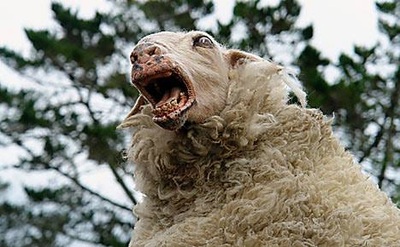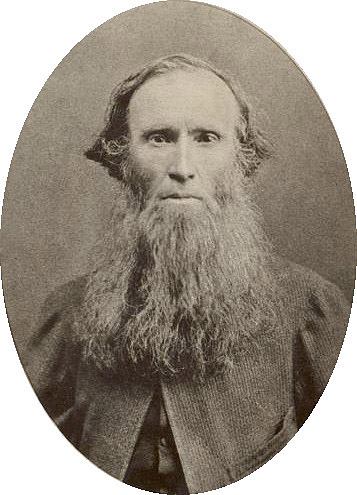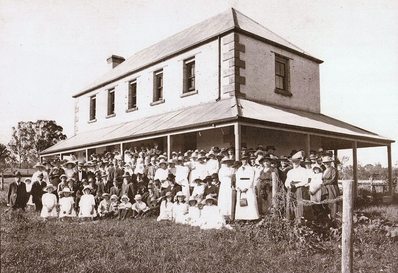
THOMPSON SQUARE – A SCHOOL MASTER, A SHEEP NAMED “BEAR” & AUSTRALIA’S FIRST POET.
By 1803 there were just over 200 children in Windsor and the surrounding district so the populace requested a School House be built.
In the Sydney Gazette 26 Aug. 1804 we read:
“The Brickwork of the Church and School-house at the Green Hills, Hawkesbury is now finished and the building newly covered. The dimensions are 101 Feet in length, 24 broad and the walls 24 Feet high, comprising the base of an upper story, an end of which is partitioned off for the residence of the instructor. It’s situation is such as to form a street behind the New Store. The design of the edifice must interest every person in it’s speedy accomplishment, as while it promotes Christianity by the benefits that accrue by Public Worship, it also illuminates the infant mind by the inculcation of moral principles and the help of such branches of useful instruction as are absolutely necessary to rescue the rising generation from the morbid glooms of ignorance.”
Macquarie’s School-houses were used for religious functions up until the 1850’s as churches like St Matthew’s, Windsor had been constructed.
The Macquaries, when in Windsor, happily attended Church services in the Green Hill’s schoolroom/chapel – “Sunday 2 Dec. 1810. Mrs M. and myself....attended Divine Service this afternoon at the temporary church at the Green Hills....Rev. Mr Robert Cartwright....gave us a most excellent discourse and read prayers extremely well.”
Of the four schoolhouses originally established by Macquarie in the Hawkesbury, only the one at Wilberforce, built in 1820, still remains – you can view the attached image on it’s centenary.
THE SCHOOLMASTER
Matthew Hughes ( convict on the “Britannia” ) taught at the school from 1810-1813 when he was transferred to Richmond school. He was replaced by Mr Joseph Harpur who taught there (1813-1826) and also acted as Parish Clerk. Joseph had been born in Kinsale, County Cork, Ireland c. 1779, had been tried in Surrey for highway robbery and transported on the “Royal Admiral” (1) in 1800 with a life sentence. He was assigned to John Macarthur and soon proved to be an able and trustworthy servant. In June 1811 Joseph was - “appointed to be Master of the Public Charity School, at Sydney in the Room of Mr Davis resigned, his salary commencing from the 19th instant.”
In 1814 he married Sarah Chidley (1789 – 1866) a convict by the “Alexander” (1), at St Matthew’s, Windsor. The couple had 8 children and the family had a comfortable home thanks to the patronage of Gov. Macquarie, John Macarthur, Samuel Marsden and Thomas Hassell. In an article written in 1888 there were still some folk around who remembered Joseph - “as a man of considerable attainments, kindly nature and great moral worth. His obituary, 1842, states – “that he was for 5 years principal superintendent of the Estate of John Macarthur while he was absent from the Colony at the time of Bligh’s arrest the onerous duties of which he discharged with credit to himself and satisfaction to his employer. He was greatly respected by all who knew him.....”
In his capacity as Parish Clerk, Joseph left in his recordings, valuable information pertaining to the building of St Matthew’s.
THE SHEEP CALLED ‘BEAR’
The provision of schools was to be assisted by the granting of 200 acres to the schoolmaster to help support himself and his family. As Joseph was familiar with the keeping of sheep from his association with John Macarthur, he had a fair flock, advertising - “For Sale, 200 young Ewes and 5 Rams .....the goodness of these sheep are well known.....300 Pound....these sheep may be seen at J. Harpur’s, Macquarie Place, Windsor.”
It appears that Joseph owned a very extraordinary and remarkable ewe, called “the Bear” because of it’s Roman nose, body shape and coarseness of wool. One day, Joseph and his two sons, found the head, skin and entrails of a sheep in their paddock behind the chapel. On inspection it was found to be “Bear”, who had been heavily in lamb. There was great upset and a general row about the whole matter. The perpetrators, who had stolen “Bear”, tied her legs together and took her to Mr Denman’s paddock for butchering, were discovered when they next made an armed attempt to rob the premises of Rev. Meare and were apprehended when one “ratted” on the others involved in the theft of “the Bear”. All four prisoners were found guilty and “the Bear”was avenged.
AUSTRALIA’S FIRST POET
Joseph and Sarah’s second son was Charles Chidley Harpur (1813-1868). He had been with his father and brother, John, when it was discovered that “the Bear” had been stolen. Charles was spoken of by an old resident who went to school with him as - “a bright, kindly dispositioned lad, with a great capacity for learning, who, when he grew up, assisted his father in his educational work”. One day, when he was 11 he wandered off into the hills and witnessed a frightening cloud burst. The experience was so powerful that the young boy decided then and there to make it, one day, into a poem....and so he did. In 1856 he wrote “A Storm in the Mountains”. He wrote many poems about his experiences, the sights and sounds of Australia. He became Australia’s first poet, was the friend and mentor of Henry Kendall and won the respect, years later, of Judith Wright who wrote a book about his work in 1963.
His abilities were down to three things.
He had grown up with access to many books and private libraries which he had avidly studied, including the works of Shakespeare. This gave him an incredible vocabulary of words and a wide range of expressions and a vast fund of literary allusions. Charles always acknowledged the remarkable moral and intellectual qualities of both his parents and his deep indebtedness to them.
But it was here, in the beautiful Hawkesbury countryside, that the young Charles passed his childhood, acquiring two things that were to influence him greatly in later years – a love for reading and a deep attachment for the Australian bush.
From Charles Harpur’s poem “Words” – “Words are deeds. The words we hear May revolutionise or rear a mighty state....”
By 1803 there were just over 200 children in Windsor and the surrounding district so the populace requested a School House be built.
In the Sydney Gazette 26 Aug. 1804 we read:
“The Brickwork of the Church and School-house at the Green Hills, Hawkesbury is now finished and the building newly covered. The dimensions are 101 Feet in length, 24 broad and the walls 24 Feet high, comprising the base of an upper story, an end of which is partitioned off for the residence of the instructor. It’s situation is such as to form a street behind the New Store. The design of the edifice must interest every person in it’s speedy accomplishment, as while it promotes Christianity by the benefits that accrue by Public Worship, it also illuminates the infant mind by the inculcation of moral principles and the help of such branches of useful instruction as are absolutely necessary to rescue the rising generation from the morbid glooms of ignorance.”
Macquarie’s School-houses were used for religious functions up until the 1850’s as churches like St Matthew’s, Windsor had been constructed.
The Macquaries, when in Windsor, happily attended Church services in the Green Hill’s schoolroom/chapel – “Sunday 2 Dec. 1810. Mrs M. and myself....attended Divine Service this afternoon at the temporary church at the Green Hills....Rev. Mr Robert Cartwright....gave us a most excellent discourse and read prayers extremely well.”
Of the four schoolhouses originally established by Macquarie in the Hawkesbury, only the one at Wilberforce, built in 1820, still remains – you can view the attached image on it’s centenary.
THE SCHOOLMASTER
Matthew Hughes ( convict on the “Britannia” ) taught at the school from 1810-1813 when he was transferred to Richmond school. He was replaced by Mr Joseph Harpur who taught there (1813-1826) and also acted as Parish Clerk. Joseph had been born in Kinsale, County Cork, Ireland c. 1779, had been tried in Surrey for highway robbery and transported on the “Royal Admiral” (1) in 1800 with a life sentence. He was assigned to John Macarthur and soon proved to be an able and trustworthy servant. In June 1811 Joseph was - “appointed to be Master of the Public Charity School, at Sydney in the Room of Mr Davis resigned, his salary commencing from the 19th instant.”
In 1814 he married Sarah Chidley (1789 – 1866) a convict by the “Alexander” (1), at St Matthew’s, Windsor. The couple had 8 children and the family had a comfortable home thanks to the patronage of Gov. Macquarie, John Macarthur, Samuel Marsden and Thomas Hassell. In an article written in 1888 there were still some folk around who remembered Joseph - “as a man of considerable attainments, kindly nature and great moral worth. His obituary, 1842, states – “that he was for 5 years principal superintendent of the Estate of John Macarthur while he was absent from the Colony at the time of Bligh’s arrest the onerous duties of which he discharged with credit to himself and satisfaction to his employer. He was greatly respected by all who knew him.....”
In his capacity as Parish Clerk, Joseph left in his recordings, valuable information pertaining to the building of St Matthew’s.
THE SHEEP CALLED ‘BEAR’
The provision of schools was to be assisted by the granting of 200 acres to the schoolmaster to help support himself and his family. As Joseph was familiar with the keeping of sheep from his association with John Macarthur, he had a fair flock, advertising - “For Sale, 200 young Ewes and 5 Rams .....the goodness of these sheep are well known.....300 Pound....these sheep may be seen at J. Harpur’s, Macquarie Place, Windsor.”
It appears that Joseph owned a very extraordinary and remarkable ewe, called “the Bear” because of it’s Roman nose, body shape and coarseness of wool. One day, Joseph and his two sons, found the head, skin and entrails of a sheep in their paddock behind the chapel. On inspection it was found to be “Bear”, who had been heavily in lamb. There was great upset and a general row about the whole matter. The perpetrators, who had stolen “Bear”, tied her legs together and took her to Mr Denman’s paddock for butchering, were discovered when they next made an armed attempt to rob the premises of Rev. Meare and were apprehended when one “ratted” on the others involved in the theft of “the Bear”. All four prisoners were found guilty and “the Bear”was avenged.
AUSTRALIA’S FIRST POET
Joseph and Sarah’s second son was Charles Chidley Harpur (1813-1868). He had been with his father and brother, John, when it was discovered that “the Bear” had been stolen. Charles was spoken of by an old resident who went to school with him as - “a bright, kindly dispositioned lad, with a great capacity for learning, who, when he grew up, assisted his father in his educational work”. One day, when he was 11 he wandered off into the hills and witnessed a frightening cloud burst. The experience was so powerful that the young boy decided then and there to make it, one day, into a poem....and so he did. In 1856 he wrote “A Storm in the Mountains”. He wrote many poems about his experiences, the sights and sounds of Australia. He became Australia’s first poet, was the friend and mentor of Henry Kendall and won the respect, years later, of Judith Wright who wrote a book about his work in 1963.
His abilities were down to three things.
He had grown up with access to many books and private libraries which he had avidly studied, including the works of Shakespeare. This gave him an incredible vocabulary of words and a wide range of expressions and a vast fund of literary allusions. Charles always acknowledged the remarkable moral and intellectual qualities of both his parents and his deep indebtedness to them.
But it was here, in the beautiful Hawkesbury countryside, that the young Charles passed his childhood, acquiring two things that were to influence him greatly in later years – a love for reading and a deep attachment for the Australian bush.
From Charles Harpur’s poem “Words” – “Words are deeds. The words we hear May revolutionise or rear a mighty state....”
